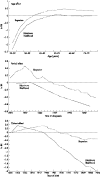Age-period-cohort analysis of cervical cancer incidence in Hong Kong from 1972 to 2001 using maximum likelihood and Bayesian methods
- PMID: 16840762
- PMCID: PMC2588081
- DOI: 10.1136/jech.2005.042275
Age-period-cohort analysis of cervical cancer incidence in Hong Kong from 1972 to 2001 using maximum likelihood and Bayesian methods
Abstract
Objective: To examine the secular effects of opportunistic screening for cervical cancer in a rich, developed community where most other such populations have long adopted organised screening.
Design, setting, and participants: The analysis was based on 15 140 cases of invasive cervical cancer from 1972 to 2001. The effects of chronological age, time period, and birth cohort were decomposed using both maximum likelihood and Bayesian methods.
Results: The overall age adjusted incidence decreased from 24.9 in 1972-74 to 9.5 per 100,000 in 1999-2001, in a log-linear fashion, yielding an average annual reduction of 4.0% (p<0.001) during the 30 year period. There were two second order and thus identifiable changes: (1) around the mid-1920s cohort curve representing an age-period interaction masquerading as a cohort change that denotes the first availability of Pap testing during the 1960s concentrated among women in their 40s; (2) a hook around the calendar years 1982-83 when cervical cytology became a standard screening test for pregnant women.
Conclusions: Hong Kong's cervical cancer rates have declined since Pap tests first became available in the 1960s, most probably because of increasing population coverage over time and in successive generations in a haphazard fashion and punctuated by the systematic introduction of routine cytology as part of antenatal care in the 1980s.
Conflict of interest statement
Conflicts of interest: none.
Similar articles
-
Modelling the impact of population-based cytologic screening on cervical cancer incidence and mortality in Hong Kong: an age--period--cohort approach.Br J Cancer. 2005 Oct 31;93(9):1077-83. doi: 10.1038/sj.bjc.6602805. Br J Cancer. 2005. PMID: 16205695 Free PMC article.
-
Trends in breast cancer incidence in Hong Kong between 1973 and 1999: an age-period-cohort analysis.Br J Cancer. 2002 Oct 21;87(9):982-8. doi: 10.1038/sj.bjc.6600583. Br J Cancer. 2002. PMID: 12434289 Free PMC article.
-
Risk factors for cervical abnormalities among Hong Kong Chinese women: a large-scale community-based cervical screening program.J Womens Health (Larchmt). 2011 Jan;20(1):53-9. doi: 10.1089/jwh.2009.1866. Epub 2010 Nov 22. J Womens Health (Larchmt). 2011. PMID: 21091197
-
Cost-effectiveness of organized versus opportunistic cervical cytology screening in Hong Kong.J Public Health (Oxf). 2004 Jun;26(2):130-7. doi: 10.1093/pubmed/fdh138. J Public Health (Oxf). 2004. PMID: 15284314
-
Epidemiology of human papillomavirus infection and cervical cancer and future perspectives in Hong Kong, Singapore and Taiwan.Vaccine. 2008 Aug 19;26 Suppl 12:M60-70. doi: 10.1016/j.vaccine.2008.05.042. Vaccine. 2008. PMID: 18945415
Cited by
-
Trends and Age-Period-Cohort Effects on the Incidence and Mortality Rate of Cervical Cancer in Korea.Cancer Res Treat. 2017 Apr;49(2):526-533. doi: 10.4143/crt.2016.316. Epub 2016 Sep 1. Cancer Res Treat. 2017. PMID: 27586676 Free PMC article.
-
Modelling the impact of population-based cytologic screening on cervical cancer incidence and mortality in Hong Kong: an age--period--cohort approach.Br J Cancer. 2005 Oct 31;93(9):1077-83. doi: 10.1038/sj.bjc.6602805. Br J Cancer. 2005. PMID: 16205695 Free PMC article.
-
Urban-rural disparity in cervical cancer in China and feasible interventions for tackling the rural excess.Medicine (Baltimore). 2019 Jan;98(1):e13907. doi: 10.1097/MD.0000000000013907. Medicine (Baltimore). 2019. PMID: 30608415 Free PMC article.
-
Comparison of Secular Trends in Cervical Cancer Mortality in China and the United States: An Age-Period-Cohort Analysis.Int J Environ Res Public Health. 2016 Nov 17;13(11):1148. doi: 10.3390/ijerph13111148. Int J Environ Res Public Health. 2016. PMID: 27869688 Free PMC article.
-
Disparities in the increases of cervical cancer incidence rates: observations from a city-wide population-based study.BMC Cancer. 2022 Apr 15;22(1):419. doi: 10.1186/s12885-022-09531-2. BMC Cancer. 2022. PMID: 35428279 Free PMC article.
References
-
- Department of Health Annual report 2002/2003. Hong Kong: Government Printers, 2003
-
- Osmond C, Gardner M J. Age, period and cohort models applied to cancer mortality rates. Stat Med 19821245–259. - PubMed
Publication types
MeSH terms
LinkOut - more resources
Full Text Sources
Medical
Research Materials





